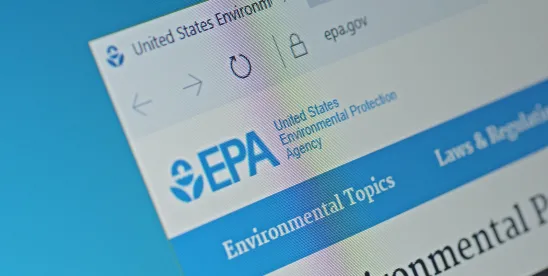Key Takeaways
- What Happened? On May 3, 2024, the U.S. Environmental Protection Agency (EPA) published its proposal to revise the Clean Air Act’s (CAA) New Source Review (NSR) preconstruction permitting program regulations. The proposed revisions would affect project emissions accounting, a process used to determine whether a modification at an existing facility triggers NSR permitting. The proposed regulatory revisions would:
- Revise the definition of “project;”
- Require emissions decreases included in Step 1 of the project emissions accounting process to be practicably enforceable; and
- Expand monitoring, recordkeeping, and reporting requirements.
These proposed revisions are a “solution” in search of a “problem” that will make NSR permitting harder than ever for no regulatory benefit. We offer a few general thoughts directly below before addressing the details of the proposal.
- EPA offers no evidence justifying the proposed revisions. EPA claims that existing NSR rules may be susceptible to industry misuse. However, EPA admits that it has no data to support its analysis. 87 Fed. Reg. 36870, 36886. So, EPA defaults to a “qualitative assessment of the potential benefits and costs of the proposal.” Id. That is arbitrary rulemaking.
- The proposal undermines the 2020 Project Emissions Accounting rule and reverses EPA’s position on denying a petition for reconsideration of that rule. EPA admits that it denied a 2021 petition for reconsideration filed by environmental advocates on the same issues raised here but then goes on, in this proposal, to reverse its position and implement the changes requested in that petition.
- Permitting major projects and expansions will take more time and money. The proposed rule will increase the time it takes to complete the NSR permitting process and, thus, the projects themselves.
- The proposed revisions will result in expanded scrutiny of operational and business decisions. The proposed revisions will further expose sources and permitting authorities to heightened scrutiny by EPA and other stakeholders inclined to challenge industry’s operational and business decisions.
- Who Is Impacted? The rule applies to existing major stationary sources in all industry categories. In addition, state, local, and tribal air pollution control agencies responsible for issuing preconstruction permits pursuant to the major NSR programs would also be affected by the proposed revisions.
- What Should I Do? Existing major stationary source owners/operators, especially those planning projects, should carefully review the proposed rule, and consider submitting comments to the docket (Docket ID No. EPA-HQ-OAR-2022-0381). Comments are due July 2, 2024.
Analysis and Key Elements of the Proposed Rule
The NSR program requires facilities to obtain a permit before constructing a new major stationary source or undertaking a “major modification” of an existing major source. EPA’s NSR regulations include a two-step test to determine if an existing major source must obtain an NSR permit for a physical change or a change in the method of operation, often referred to as a “project.”
In November 2020, EPA promulgated the Project Emissions Accounting rule (PEA rule) to clarify the applicable accounting procedures to determine when a physical change or change in the method of operation at a major stationary source would result in a significant emissions increase.1 The PEA rule clarified that both emissions increases and decreases from projects may be considered in Step 1 of the NSR major modification applicability test. This was a significant change, codifying the Project Emissions Accounting interpretation initially issued in a 2018 memorandum from then-Administrator Scott Pruitt.
A project is a “major modification” requiring an NSR permit if it would result in: a significant emissions increase (can include both increases and decreases in emissions as part of the project) of an NSR pollutant (Step 1); and a significant net emissions increase of an NSR pollutant from the source, accounting for emissions increases and decreases attributable to other projects undertaken at the source that are “contemporaneous to the project” (generally within a five-year period plus construction) (Step 2).
Key proposed changes to the NSR regulations that are discussed in further detail below are:
- The revised definition of “project;”
- Requiring enforceable Step 1 emissions reductions; and
- Clarifying and expanding “reasonable possibility” recordkeeping and reporting requirements.
- Revised Definition of Project. EPA proposes to revise the definition of “project,” currently defined as ‘‘a physical change in, or change in the method of operation of, an existing major stationary source.’’2 EPA proposes to narrow the definition of “project” to read as follows: “[a] discrete physical change in, or change in the method of operation of, an existing major stationary source, or a discrete group of such changes (occurring contemporaneously at the same major stationary source) that are substantially related to each other. Such changes are substantially related if they are dependent on each other to be economically or technically viable.”
EPA claims that this revision is necessary to protect against the potential for sources to “selectively aggregate or disaggregate multiple projects such that they are able to avoid major NSR in a manner that is contrary to the intent of the CAA.” Id. at 36878. However, EPA presents scant evidence of any instance where a source has unlawfully circumvented the CAA in this manner. EPA appears to cite two Title V permit petitions where the petitions objecting to Title V permits were partially granted not because the sources clearly circumvented the CAA, but instead because the permitting records were deemed inadequate to support past non-Title V permitting decisions by the respective permitting authorities. (Note: it appears that EPA’s stated cross reference in footnote 73 of the Federal Register notice to footnote 67 should have cross-referenced footnote 65 instead.)
EPA’s proposed revisions to the definition of “project” would further complicate the NSR permitting process and increase the burden on major source owners/operators, as well as permitting authorities. Under the proposed rule, permitting authorities would additional responsibility to assess the economic and technical viability of a major source’s physical and operational changes. These proposed revisions could potentially increase the amount of time needed to complete the permitting process, and they increase the potential for challenges to permitting actions, which would further burden major source owners/operators and permitting authorities. The last sentence of the proposed new “project” definition also gives EPA and other stakeholders expanded latitude to challenge major sources’ operational and business decisions.
- Enforceable Step 1 Emissions Reductions. EPA also proposes that emissions decreases associated with a project under Step 1 be legally and practicably enforceable, which EPA considers to mean “enforceable as a practical matter.” EPA proposes to revise the regulations by specifying that “a decrease may only be accounted for in the significant emissions increase determination if it meets the requirements under 40 C.F.R. § 52.21(b)(3)(vi)(b)”to the “significant emissions increase” definition at 40 C.F.R. § 52.21(a)(2)(iv)(g). EPA also proposes analogous regulatory language for 40 C.F.R. § 51.165, 40 C.F.R. § 51.166, and Appendix S to 40 C.F.R. Part 51.
EPA states that it is proposing this change to ensure that emissions decreases included in the NSR applicability process will occur and be maintained. EPA further states that this is consistent with Clean Air Act Section 110’s requirement that “each implementation plan submitted by a State include enforceable emission limitations” and “regulation of the modification and construction of any stationary source within the areas covered by the plan as necessary to assure that national ambient air quality standards are achieved, including a permit program as required in parts C and D of this subchapter.” This new requirement would require Step 1 emissions decreases to be “creditable”—meaning that a decrease can only be accounted for in Step 1 if it meets the creditability requirements for decreases in the existing “significant net emissions increase” definition (Step 2).
EPA acknowledges that in the 2002 NSR reform rule, the Agency elected not to require that projected actual emissions be made enforceable. Nonetheless, EPA says here, without any evidence of abuses that it is seeking to remedy, that there “may” be a reason to require that decreases be made enforceable—hardly a ringing endorsement for its proposal.
- Reasonable Possibility Reporting and Recordkeeping. EPA proposes to both clarify and expand the recordkeeping and reporting requirements in the NSR regulations’ “reasonable possibility” provisions that apply to projects at major stationary sources and are evaluated using the actual-to-projected-actual applicability test. The reasonable possibility provisions apply when an owner / operator determines that the project does not qualify as a major modification but where there is a “reasonable possibility” that the project may nonetheless result in a significant emissions increase.
EPA proposes to clarify:
- The emissions units to include in the project actual emissions calculation;
- The calculation to include in the description of the applicability test used to determine that the project is not a major modification;
- The emissions units to include in the monitoring requirement at 40 C.F.R. § 52.21(r)(6)(iii);
- The provisions applying to projects involving an electric utility steam generating unit; and
- The emissions units to include in the ‘‘projected actual emissions increase’’ used to determine whether there is a ‘‘reasonable possibility’’ under 40 C.F.R. § 52.21(r)(6)(vi).
EPA further proposes to expand the reasonable possibility provisions with the following new requirements:
- A source is subject to the reasonable possibility provisions if a decrease is accounted for in the Step 1 significant emissions increase determination;
- Removing the distinction between electric utility steam generating units and all other sources with respect to the submission of pre-project records; and
- Adding records that must be submitted to the reviewing authority when the source is subject to the reasonable possibility provisions for a particular project.
EPA’s proposed clarifications and expansion of the reasonable possibility provisions represent significant additional time and resource costs for major source owners/operators undertaking projects. These expanded requirements also increase the possibility of delaying permitting actions. EPA states explicitly that the impetus for these revisions is the (denied) petition for reconsideration. Id. at 36833.
EPA also proposes revisions to clarify statutory limitations on netting in nonattainment NSR. The proposed revisions apply to serious, severe, and extreme nonattainment areas. They would establish that for these nonattainment areas, emissions increases over any period of five consecutive years should be aggregated when determining whether there is a significant net emissions increase. In extreme nonattainment areas, the CAA does not allow project emissions accounting.
EPA also requests comment on several issues, including, but not limited to:
- Whether to adopt additional requirements to prevent double counting of emissions reductions;
- Whether a specific temporal component of the project aggregation criteria—i.e., the three-year rebuttable presumption from the 2018 final action on project aggregation—should be retained;
- The types of projects that would be impacted by a requirement that emission decreases accounted for under Step 1 of the NSR applicability process be enforceable prior to beginning actual construction and the effect that such a requirement would have on project decision-making and project outcomes; and
- Finally, showing its true colors here, EPA also asks for comment on expressly reversing the PEA rule and only allowing increases to be considered under the Step 1 significant emissions increase determination. Id. at 36881.
1 Prevention of Significant Deterioration (PSD) and Nonattainment New Source Review (NNSR): Project Emissions Accounting, 85 Fed. Reg. 74890 (Nov. 24, 2020).
2 40 C.F.R. § 51.165(a)(1)(xxxix); 40 C.F.R. § 51.166(b)(51); 40 C.F.R. Part 51, Appendix S II.A.33.; 40 C.F.R. § 52.21(b)(52).








 />i
/>i

